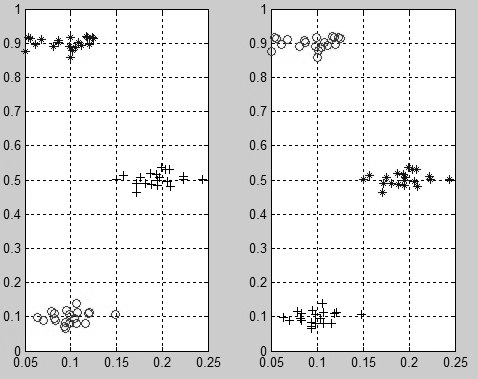当前你的浏览器版本过低,网站已在兼容模式下运行,兼容模式仅提供最小功能支持,网站样式可能显示不正常。
请尽快升级浏览器以体验网站在线编辑、在线运行等功能。
3718:Similarity
题目描述
When we were children, we were always asked to do the classification homework. For example, we were given words {Tiger, Panda, Potato, Dog, Tomato, Pea, Apple, Pear, Orange, Mango} and we were required to classify these words into three groups. As you know, the correct classification was {Tiger, Panda, Dog}, {Potato, Tomato, Pea} and {Apple, Pear, Orange, Mango}. We can represent this classification with a mapping sequence{A,A,B,A,B,B,C,C,C,C}, and it means Tiger, Panda, Dog belong to group A, Potato, Tomato, Pea are in the group B, and Apple, Pear, Orange, Mango are in the group C.
But the LABEL of group doesn't make sense and the LABEL is just used to indicate different groups. So the representations {P,P,O,P,O,O,Q,Q,Q,Q} and {E,E,F,E,F,F,W,W,W,W} are equivalent to the original mapping sequence. However, the representations {A,A,A,A,B,B,C,C,C,C} and
{D,D,D,D,D,D,G,G,G,G} are not equivalent.

The pupils in class submit their mapping sequences and the teacher should read and grade the homework. The teacher grades the homework by calculating the maximum similarity between pupils' mapping sequences and the answer sequence. The definition of similarity is as follow.
Similarity(S, T) = sum(Si == Ti) / L
L = Length(S) = Length(T), i = 1, 2,... L,
where sum(Si == Ti) indicates the total number of equal labels in corresponding positions. The maximum similarity means the maximum similarities between S and all equivalent sequences of T, where S is the answer and fixed. Now given all sequences submitted by pupils and the answer sequence, you should calculate the sequences' maximum similarity.
But the LABEL of group doesn't make sense and the LABEL is just used to indicate different groups. So the representations {P,P,O,P,O,O,Q,Q,Q,Q} and {E,E,F,E,F,F,W,W,W,W} are equivalent to the original mapping sequence. However, the representations {A,A,A,A,B,B,C,C,C,C} and
{D,D,D,D,D,D,G,G,G,G} are not equivalent.

The pupils in class submit their mapping sequences and the teacher should read and grade the homework. The teacher grades the homework by calculating the maximum similarity between pupils' mapping sequences and the answer sequence. The definition of similarity is as follow.
Similarity(S, T) = sum(Si == Ti) / L
L = Length(S) = Length(T), i = 1, 2,... L,
where sum(Si == Ti) indicates the total number of equal labels in corresponding positions. The maximum similarity means the maximum similarities between S and all equivalent sequences of T, where S is the answer and fixed. Now given all sequences submitted by pupils and the answer sequence, you should calculate the sequences' maximum similarity.
输入解释
The input contains multiple test cases. The first line is the total number of cases T (T < 15). The following are T blocks. Each block indicates a case. A case begins with three numbers n (0 < n < 10000), k (0 < k < 27), m (0 < m < 30), which are the total number of objects, groups, and students in the class. The next line consists of n labels and each label is in the range [A...Z]. You can assume that the number of different labels in the sequence is exactly k. This sequence represents the answer. The following are m lines, each line contains n labels and each label also is in the range [A...Z]. These m lines represent the m pupils' answer sequences. You can assume that the number of different labels in each sequence doesn't exceed k.
输出解释
For each test case, output m lines, each line is a floating number (Round to 4 digits after the decimal point). You should output the m answers in the order of the sequences appearance.
输入样例
2 10 3 3 A A B A B B C C C C F F E F E E D D D D X X X Y Y Y Y Z Z Z S T R S T R S T R S 3 2 2 A B A C D C F F E
输出样例
1.0000 0.7000 0.5000 1.0000 0.6667
来自杭电HDUOJ的附加信息
| Author | LIN, Yue |
| Recommend | zhouzeyong |
最后修改于 2020-10-25T23:06:22+00:00 由爬虫自动更新
共提交 0 次
通过率 --%
| 时间上限 | 内存上限 |
| 4000/2000MS(Java/Others) | 65536/65536K(Java/Others) |
登陆或注册以提交代码